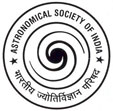Falling for ‘NASA’ Label
What happened:
On 19th and 20th August, the ANI news agency released a story of a 14 year old girl from Aurangabad, Maharashtra being selected as a panelist in some virtual NASA meeting and getting awarded a fellowship. The release also mentioned that her paper was selected to be published by NASA.
Weblink of the original Report:
twitter.com/ANI/status/1428336372226478080?s=20
And in case ANI chooses to delete the tweets, here are the screenshots:
First Tweet:

Second Tweet:
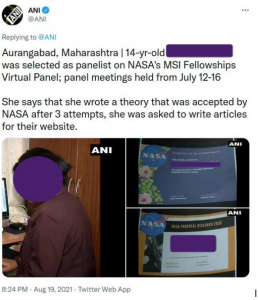
Third Tweet:
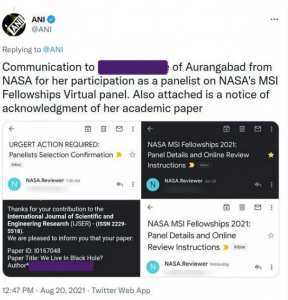
Several news outlets including web portals of national newspapers carried this ANI story on their own portals in the morning hours of 20th August 2021. But most of these articles were withdrawn by 14:00 hrs of the same day.
We have hidden the identity of the student and her family to maintain their privacy.
Why it is wrong?:
The paper:
How new research gets published and accepted by other scientists is often misunderstood by people outside academics. It is true that you have to send your research to an academic journal, which will get it checked by some other scientists and then will publish it. It is also unfortunately true that some journals demand processing charges from the authors. However, there are too many bad journals lurking in the back alleys of academic publishing, looking to exploit unsuspecting authors. They would publish anything and everything given to them without any quality checks. They just make money by charging such authors. This is called ‘predatory publishing’ in academic circles.

If you look at the email screenshot shared by ANI (see above) and then trace this IJSER journal to its website, there are ample indications that it is a predatory journal. It is also explicitly listed as such in the list of predatory journals maintained here: https://predatoryjournals.com/
The ANI tweets mention the topic of the paper as something about “Black holes and God”. Such a topic can be part of academic discussions in philosophy or theology. But most scientific journals will reject such a paper in the initial scrutiny itself. Scientific publications demand rigorous physical evidence and analysis. Any argument connecting two unrelated concepts like black holes and god will be just a speculative play on words, which doesn’t qualify as physical evidence.
The Certificates:
The tweet 2 of ANI shows two certificates purportedly issued to the student by NASA. They are so amateurishly done (the format of the certificate is a standard template of a popular DTP software) that no serious researcher or journalist would believe that they have been issued by NASA. The last certificate shows names of two NASA authorities (Jim Bridestine and James Federick). Former is listed as CEO & President. There is no such position at NASA. Also the two names appear to be a rip-off of the name of a former NASA administrator James Frederick Bridenstine, who was often called Jim by his colleagues.
Selection as Panelist:
It is impossible that NASA or any other credible agency would invite a 13-14 year old non-citizen student, who has no academic pedigree, to evaluate serious research proposals. It may happen by accident if some NASA admin staff gets confused between names of the student and some other person they actually wanted to invite. Alternatively, the student may be the victim of some prank played by someone not related to NASA. All the emails shared by ANI (see below) seem to be addressed to senior academics. So it is difficult to imagine a valid
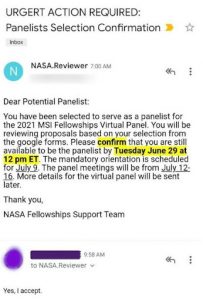

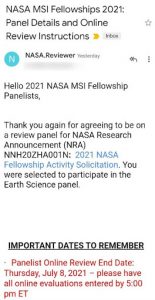
scenario in which this invite would be sent to a 14 year old student. As multiple users have pointed out on twitter, we also do not find any evidence of existence of so-called MSI fellowships. There is one unrelated NASA programme (https://www.nasa.gov/stem/murep/minority-serving-institutions-rotation-opportunity.html) where acronym can be MSI but the emails don’t make any reference to this programme.
Thus, the whole being panelist for NASA business is also extremely suspicious.
Summary:
It is very clear that all details of the story are a hoax. This is not the first time such claims about NASA honouring very young kids from smaller Indian cities (scholarships / astronaut training / awards etc) have surfaced in Indian media. On an average we do see similar stories once every year. Names, towns, details of honours change but the basic story remains the same. “Some young student, typically from an underprivileged background, and under-appreciated in the Indian school system, is spotted by NASA for his/her enormous talent and is awarded” is the crux of all such stories. Sometimes student and parents are victims of a fraud to dupe them of money, sometimes it is over ambitious parents who want to hog their 15 minutes of fame and sometimes it is the student itself who is pulling a fast one on others.
If either student or the parents are part of this hoax, then obviously they will lose credibility. But if they are also the victim of a fraud committed by some unknown parties, then that raises the question why so many Indian parents are falling for such scams? What kind of support systems should we create so that either the student or the people around him/her spot this scam early enough to prevent it from happening.
The biggest culprit in this current scam is the ANI news agency. It is the fundamental duty of any journalist to do basic fact checking before filing any story. If that journalist would have spoken with any credible academic researcher, they would have been alerted to multiple problems in this story and would have been cautioned against publishing it. Clearly, that has not happened. As a result, another Indian student has been roasted over social media. All this was certainly avoidable.
